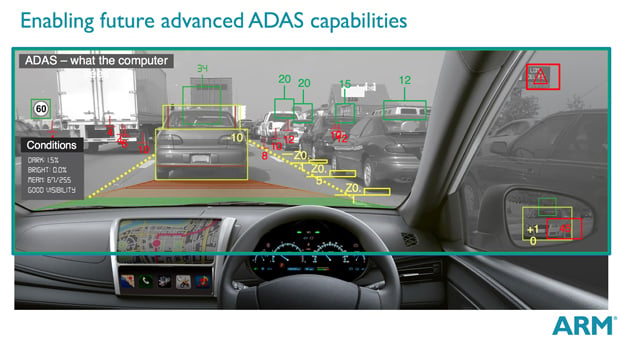ARM To Fuel Fully-Autonomous Driving With 100x Increase In Cortex Computing Performance By 2024
Cambridge, UK-based ARM doesn’t just supply the processor architecture that powers the majority of our smartphones and tablets (along with numerous other IoT devices), but its products also help to power safety, control, and infotainment systems in the vehicles that we all drive — well, that is if your vehicle isn’t already driving you thanks to rapid advances in autonomous technology.
ARM has already managed to incorporate its Cortex-A, Cortex-M, and Cortex-R architectures into vehicles to power blind spot detection, 360-degree surround views (Nissan/Infiniti is deeply invested in this technology), automatic parking, automatic braking, automatic cruise control, collision avoidance, and lane-keeping. With many luxury marque producing vehicles that include ALL of those systems in one vehicle, a lot of processing power is required to keep all of these systems running properly simultaneously.
That need for Scotty to deliver “more power” will only grow in the coming years. ARM estimates that the compute performance of 2024 model year vehicles will need to increase 100x compared to today’s 2016 model year vehicles equipped with Advanced Driver Assistance Systems (ADAS). As you can see in the diagram below, processing/software platforms will need to bulk up accordingly as we step closer to fully autonomous driving within the next decade.
The use of ultrasonic sensors is expected to triple, and 4K cameras will be able to deliver higher resolution imagery that ARM’s Cortex processors will use to make decisions on how to steer, accelerate, and brake your vehicle. And situational awareness will improve thanks to an increasing prevalence of 360-degree cameras.
By 2024, ARM feels that we will have enough processing power and data throughput (both 100x greater than 2016 levels) to deliver consumer-level autonomous driving, high-speed “all-around” collision avoidance, vehicle-to-vehicle communications, and vehicle-to-infrastructure support (i.e. vehicles communicating with traffic sensor embedded in the road, traffic signals, etc.). Within the next decade, our cars will be packed with hundreds of chips and sensors including fully heterogeneous Cortex cores built on a 10nm manufacturing process.
“Exciting new technologies are being deployed by manufacturers to make vehicle intelligence the prime consideration for consumers,” said Richard York, VP of embedded marketing at ARM. “ADAS promises far greater intelligence and road safety, and the efficiency advantages of the ARM ecosystem mean our partners are well-positioned to deliver this technology. Today’s announcement re-affirms our commitment to help shape future automotive markets.”
While technology is progressing at a rapid clip, I’m not quite sure that I’m ready to hand over the wheel just yet to a computer. I’m still [relatively] young and I’ve always enjoyed driving since I first received my license at age 16. Perhaps when I get a bit older, I’ll feel differently, and will simply sit back and let my electronic chauffeur drive me around to any given destination.




